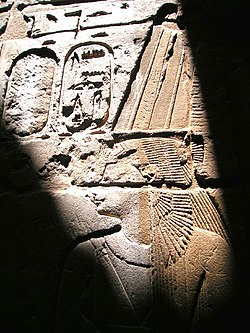| Amenirdis I | |
|---|---|
| Divine Adoratrice of Amun God's Wife of Amun | |
 Amenirdis in Medinet Habu | |
| Egyptian name | |
| Tenure | 714–700 BCE |
| Predecessor | Shepenupet I |
| Successor | Shepenupet II |
| Dynasty | 25th Dynasty |
| Burial | Medinet Habu [2] |
| Father | Kashta |
| Mother | Pebatjma |
Amenirdis I (throne name: Hatneferumut) was a God's Wife of Amun during the 25th Dynasty of ancient Egypt. [3] Originating from the Kingdom of Kush, she was the daughter of Pharaoh Kashta and Queen Pebatjma, and was later adopted by Shepenupet I. She went on to rule as high priestess, and has been shown in several artifacts from the period.